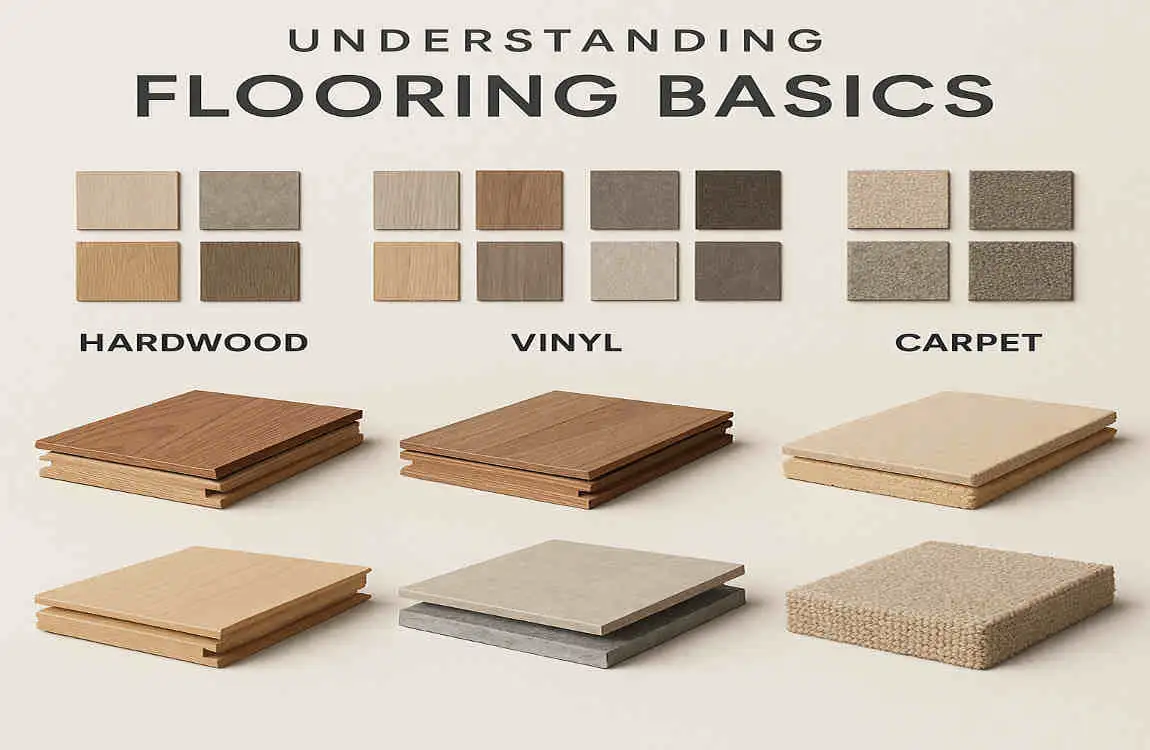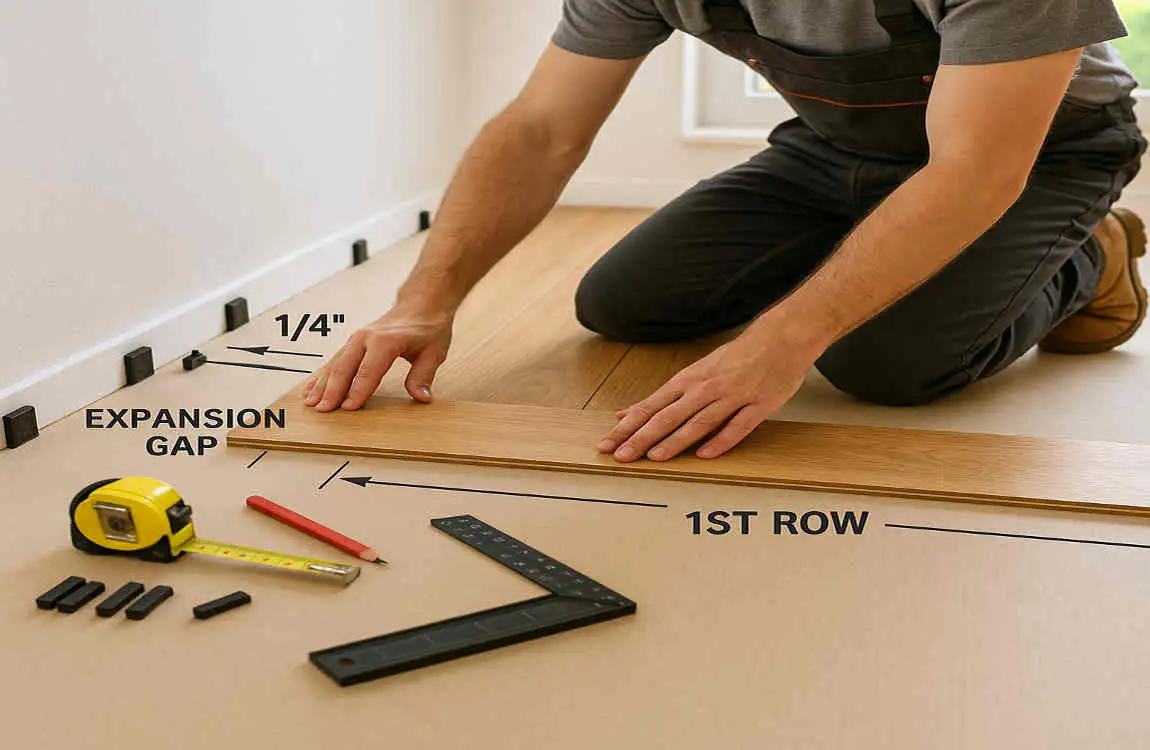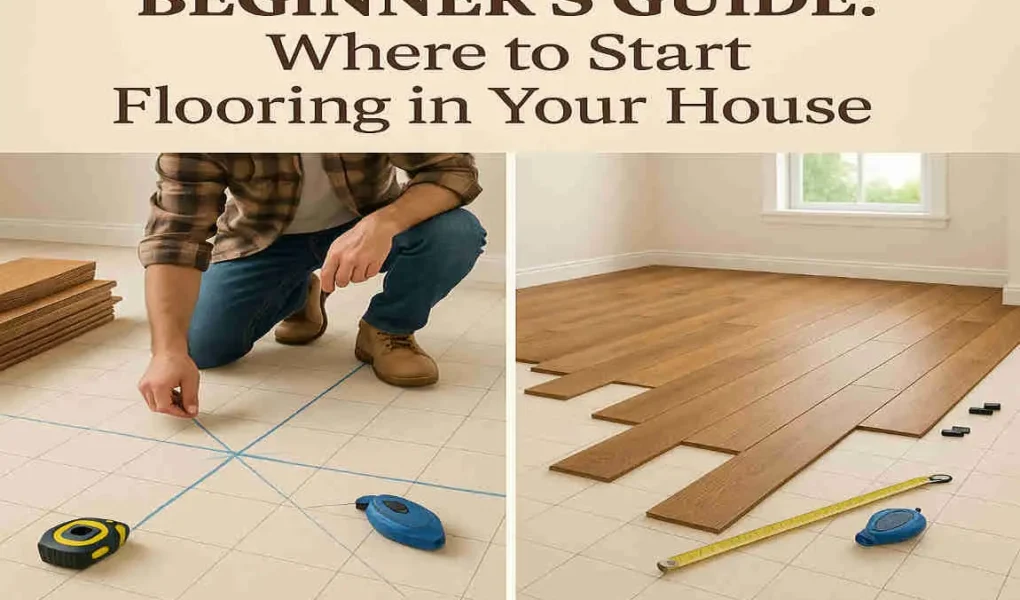Flooring plays a crucial role in home improvement projects. It not only enhances the aesthetic appeal of your home but also adds value and comfort. As a beginner, knowing where to start flooring in a house can make a significant difference in the success of your project.
Understanding Flooring Basics

Types of Flooring Materials
When it comes to flooring, you have several options to choose from:
- Hardwood: Known for its durability and timeless appeal, hardwood flooring adds warmth and character to any space.
- Laminate: An affordable alternative to hardwood, laminate flooring is easy to install and maintain.
- Tile: Perfect for high-traffic areas like kitchens and bathrooms, tile flooring is durable and moisture-resistant.
- Vinyl: Versatile and budget-friendly, vinyl flooring is available in a variety of styles and is suitable for any room.
- Carpet: Ideal for bedrooms and living areas, carpet provides comfort and insulation.
Pros and Cons of Each Material
Each flooring material has its advantages and disadvantages:
- Hardwood: Pros – Durable, timeless, adds value. Cons: Expensive, requires maintenance, and susceptible to moisture.
- Laminate: Pros – Affordable, easy to install, low maintenance. Cons: Not as durable as hardwood, can’t be refinished.
- Tile: Pros – Durable, moisture-resistant, easy to clean. Cons: Cold underfoot, grout requires regular maintenance.
- Vinyl: Pros – Affordable, versatile, easy to maintain. Cons: Not as durable as other options, and can be slippery.
- Carpet: Pros – Comfortable, insulating, affordable. Cons: Requires frequent cleaning, can trap allergens.
Factors Affecting Flooring Choice
When deciding on the right flooring material, consider the following factors:
- Style: Choose a flooring option that complements your home’s decor and personal taste.
- Durability: Consider the traffic and usage of the room when selecting a flooring material.
- Budget: Set a realistic budget for your flooring project, taking into account the costs of materials and installation.
- Maintenance: Assess the level of maintenance required for each flooring option and choose one that fits your lifestyle.
Preparing Your Home for Flooring Installation
Assessing the Current Floor Condition
Before starting your flooring project, assess the condition of your existing floor:
- Removal: If you have old flooring that needs to be removed, plan for the time and effort required to complete the task.
- Repair: Inspect the subfloor for any damage or unevenness, and make the necessary repairs before installing new flooring.
Clearing and Cleaning the Area
To ensure a smooth installation process, clear and clean the area thoroughly:
- Remove Furniture: Remove all furniture and decorative items from the room.
- Clean the Subfloor: Sweep, Vacuum, and mop the subfloor to remove any dirt, dust, or debris.
Importance of Measuring Your Space Accurately
Accurate measurements are crucial for a successful flooring project:
- Measure the Room: Take precise measurements of the room’s length and width.
- Calculate Square Footage: Multiply the length by the width to determine the square footage of the room.
- Add Extra: Add 5-10% extra to your calculations to account for waste and cutting.
Tools and Materials Required for a Beginner
As a beginner, you’ll need the following tools and materials:
- Measuring Tape: For accurate measurements.
- Utility Knife: For cutting flooring materials.
- Hammer: For installing nails or tapping boards into place.
- Level: To ensure your flooring is even and level.
- Flooring Adhesive: Depending on the type of flooring you choose.
- Underlayment: For added comfort and soundproofing.
Where to Start Flooring in a House: Key Considerations
Entry Point Decision
The starting point of your flooring installation matters for several reasons:
- Aesthetics: The starting point can affect the overall appearance of your flooring.
- Ease of Installation: Choosing the right starting point can make the installation process easier and more efficient.
- Room Layout: Consider the shape and layout of your room when deciding where to start.
Common Starting Points
There are several common starting points for flooring installation:
- Main Entrance: Starting at the main entrance can create a seamless transition into the room.
- Longest Wall: Beginning along the longest wall can help maintain straight lines and even spacing.
- Most Visible Area: Starting in the most visible area of the room can create a focal point and enhance the overall appearance.
Room Shape and Layout
The shape and layout of your room can influence where you start your flooring:
- Rectangular Rooms: Start along the longest wall for a more efficient installation process.
- Square Rooms: Begin in the center of the room and work your way outward.
- Irregularly Shaped Rooms: Start in the most visible area and work around the room’s unique features.
Handling Tricky Areas
When installing flooring, you’ll encounter tricky areas like corners, doorways, and transitions:
- Corners: Use a jigsaw or coping saw to cut flooring materials to fit around corners.
- Doorways: Install a transition strip to create a smooth transition between different flooring types or rooms.
- Transitions: Use a T-molding or reducer strip to transition between flooring types or heights.
Step-by-Step Guide to Starting Flooring Installation

Planning Your Layout and Pattern
Before starting your flooring installation, plan your layout and pattern:
- Determine the Direction: Decide which direction you want your flooring to run, considering the room’s shape and layout.
- Choose a Pattern: Select a flooring pattern that complements your room’s style and enhances its visual appeal.
Laying the Underlayment
Underlayment is essential for a smooth and comfortable flooring installation:
- Choose the Right Underlayment: Select an underlayment that is compatible with your flooring material and provides the desired level of comfort and soundproofing.
- Install the Underlayment: Roll out the underlayment across the entire floor, ensuring it is smooth and even.
Marking Your Starting Point
Precisely marking your starting point is crucial for a successful flooring installation:
- Use a Chalk Line: Snap a chalk line along your starting point to create a straight and visible guide.
- Double-Check Your Measurements: Verify that your starting point aligns with your room’s measurements and layout.
Installing the First Row
The first row of flooring sets the tone for the entire installation:
- Start with a Straight Edge: Begin with a straight edge to ensure your first row is perfectly aligned.
- Use Spacers: Place spacers between the first row and the wall to allow for expansion and contraction.
Continuing Rows and Maintaining Spacing
As you continue installing rows, maintain consistent spacing:
- Use a Flooring Spacer: Place a flooring spacer between each row to ensure even spacing.
- Stagger the Joints: Stagger the joints of each row to create a more stable and visually appealing flooring pattern.
Dealing with Obstacles
When encountering obstacles like vents, cabinets, and thresholds, follow these tips:
- Cut Around Obstacles: Use a jigsaw or coping saw to cut flooring materials to fit around obstacles.
- Install Transition Strips: Use transition strips to create a smooth transition between flooring types or heights.
Final Touches
Complete your flooring installation with these final touches:
- Install Trim and Baseboards: Install trim and baseboards to cover the expansion gap and create a finished look.
- Clean the Floor: Thoroughly clean the floor to remove any debris or dust that may have accumulated during the installation process.
Tips for a Successful DIY Flooring Project
Avoiding Common Mistakes
As a beginner, avoid these common mistakes:
- Rushing the Process: Take your time and follow the installation steps carefully.
- Neglecting the Subfloor: Ensure your subfloor is clean, level, and properly prepared before installing new flooring.
- Ignoring the Manufacturer’s Instructions: Always follow the manufacturer’s instructions for your specific flooring material.
Maintaining Straight Lines and Even Spacing
To maintain straight lines and even spacing throughout your flooring installation:
- Use a Chalk Line: Snap a chalk line along each row to ensure straight and even spacing.
- Check Your Progress: Regularly inspect your progress to ensure your flooring is properly aligned and spaced.
Safety Tips
When handling tools and materials, prioritize safety:
- Wear Protective Gear: Wear gloves, safety glasses, and a dust mask when cutting or installing flooring materials.
- Use Tools Safely: Follow the manufacturer’s instructions for using tools safely and efficiently.
- Lift with Your Legs: When lifting heavy materials, use your legs, not your back, to avoid injury.
When to Consider Hiring a Professional
While DIY flooring installation can be rewarding, consider hiring a professional in these situations:
- Complex Installations: If your flooring project involves complex patterns or multiple flooring types, a professional may be better equipped to handle the job.
- Large Areas: For large areas or multiple rooms, a professional can complete the installation more efficiently and effectively.
- Limited Time or Skills: If you have limited time or lack the necessary skills for a successful flooring installation, hiring a professional can save you time and frustration.
Flooring Installation by Room Type
Special Considerations for Different Rooms
When installing flooring in different rooms, keep these special considerations in mind:
- Kitchen: Opt for a durable and moisture-resistant flooring option, such as tile or vinyl.
- Bathroom: Opt for a water-resistant flooring material, such as tile or vinyl, and consider installing a subfloor to prevent moisture damage.
- Living Room: Choose a flooring option that complements your living room’s style and can withstand high traffic, such as hardwood or laminate flooring.
- Basement: Select a moisture-resistant flooring material, such as vinyl or engineered hardwood, and ensure proper subfloor preparation to prevent moisture damage.
Moisture-Resistance and Flooring Choices
When selecting modern flooring for moisture-prone areas, consider these options:
- Tile: Highly moisture-resistant and suitable for kitchens, bathrooms, and basements.
- Vinyl: Water-resistant and available in various styles, making it a versatile choice for any room.
- Engineered Hardwood: More moisture-resistant than solid hardwood, making it a better option for basements and bathrooms.
Adjusting Your Starting Point
Based on the function and shape of each room, adjust your starting point accordingly:
- Kitchen: Start along the longest wall to create a seamless transition into the room.
- Bathroom: Begin in the center of the room and work your way outwards to accommodate the room’s unique features.
- Living Room: Start in the most visible area to create a focal point and enhance the room’s overall appearance.
- Basement: Begin along the longest wall and work around any obstacles or irregularities in the room’s layout.
Cost and Time Expectations
Approximate Costs
When budgeting for your flooring project, consider these approximate costs:
- Materials: $1-$10 per square foot, depending on the type of flooring you choose.
- Tools: $50-$200 for basic tools like a utility knife, hammer, and level.
- Underlayment: $0.50-$1.50 per square foot, depending on the type and quality of underlayment.
Estimated Time
The time required to complete your flooring project depends on the room size and type:
- Small Room (100-200 sq ft): 1-2 days for a beginner.
- Medium Room (200-400 sq ft): 2-3 days for a beginner.
- Large Room (400-600 sq ft): 3-4 days for a beginner.
Budget-Friendly Tips
To save money on your flooring project without compromising quality:
- Shop Around: Compare prices from multiple retailers to find the best deals on flooring materials.
- Consider Alternatives: Opt for a more affordable flooring option, such as laminate or vinyl, instead of hardwood or tile.
- DIY Installation: Save on labor costs by installing the flooring yourself, following the steps outlined in this guide.
Maintaining Your New Floor
Best Practices for Cleaning and Upkeep
To keep your new floor looking its best, follow these best practices:
- Sweep or Vacuum Regularly: Remove dirt and debris from your floor to prevent scratching and damage.
- Clean Spills Immediately: Wipe up spills promptly to prevent staining and moisture damage.
- Use the Right Cleaning Products: Select cleaning products that are specifically designed for your flooring material and follow the manufacturer’s instructions carefully.
Impact of Proper Installation
Proper installation can significantly impact the long-term durability of your floor:
- Even Spacing: Maintaining even spacing between flooring planks or tiles can prevent buckling and uneven wear.
- Proper Subfloor Preparation: Ensuring your subfloor is clean, level, and adequately prepared can prevent moisture damage and unevenness.
- Following the Manufacturer’s Instructions: Adhering to the manufacturer’s installation instructions ensures that your floor is installed correctly and lasts for years to come.
Minor Repairs
When your floor requires minor repairs, follow these steps:
- Identify the Issue: Determine the cause of the problem, such as a scratch, dent, or loose plank.
- Gather the Right Tools: Collect the necessary tools and materials for the repair, such as a utility knife, wood filler, or replacement plank.
- Follow the Manufacturer’s Instructions: Refer to the manufacturer’s instructions for specific guidance on repairing your flooring material.
- Test in an Inconspicuous Area: Before attempting the repair, test the process in an inconspicuous area to ensure the desired results are achieved.




